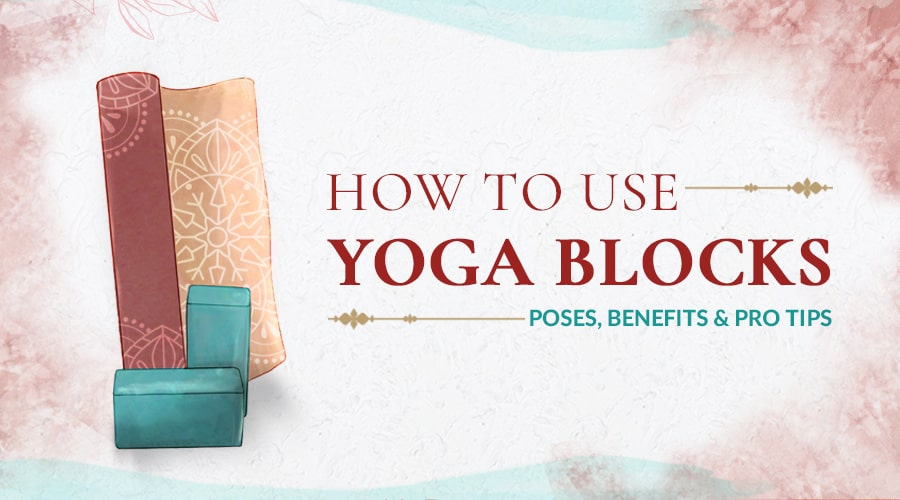Yoga blocks are designed to be the ultimate training buddy for yogis. Solid and supportive, they are there when you need an extra push or a place to rest, recover or relax deeper into a challenging asana.
Although these nifty little props have proven their value to us time and time again, many practitioners think of them as too ‘beginner’ or an easy shortcut. I admit that I also hesitated to pick up a yoga block when I started practicing yoga as I didn’t want it to derail my progress.
But after time, I realized just how valuable these props are for both beginner and advanced practitioners. The tiny blocks can play a significant role in our daily practice, helping to deepen our training and safely push us past our boundaries. Plus, they have the power to modify or elevate any yoga asana, making them a must in any practitioner’s toolkit.
So, whether you’ve just started yoga or are an experienced teacher, this blog will break down how to use yoga blocks safely and effectively. We’ll also explore the best yoga block poses and how these props can bolster your practice!
What is a Yoga Block?
Also known as a yoga brick, a yoga block is a rectangular foam or cork block typically used as a prop to assist in balancing, support, or alignment in yoga asana practice.
The use of yoga blocks was first introduced by B.K.S. Iyengar to assist with alignment and help practitioners reach a new dimension in their asana practice. Today, yoga blocks are one of the most popular and versatile props used in studios worldwide with a variety of uses.
How to Use Yoga Blocks: Best Yoga Block Poses
It’s a common misconception that yoga blocks are only used to support the body during practice. Yoga blocks are incredibly versatile props with three main functions: bridge a gap, support our body weight, and build strength.
To ensure you make the most out of your yoga block, we’ve compiled the best yoga block poses for these various uses.
1. Bridge the Gap – Safely Increase Your Level of Mobility with a Yoga Block
Standing and seated yoga folds are postures where a yoga block can be a useful tool. For example, suppose you struggle to reach the floor or lengthen fully in a pose. In that case, a yoga block can bridge the gap and allow you to perform poses that might be inaccessible due to limited flexibility at that time. It also ensures you maintain proper alignment and avoid injury or strain, and that you work on the intended target area of the pose.
Extended Side-Angle Pose (Utthita Parshvakonasana)
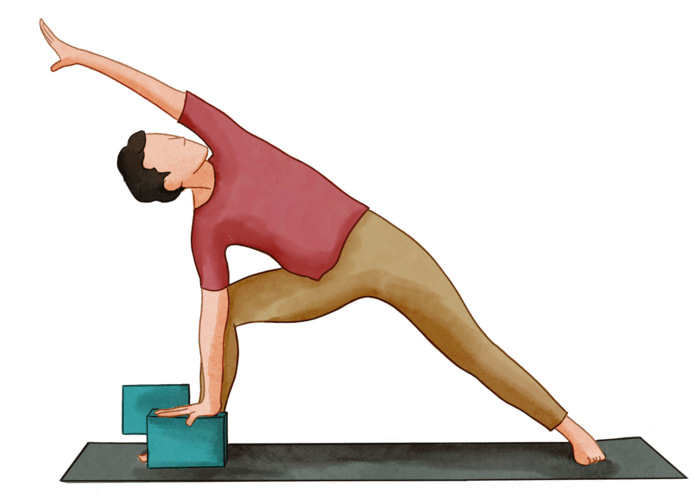
Use a yoga block for a deeper stretch in the side body, chest, shoulders, spine, and groin. If you struggle to reach the floor, a yoga block can offer more stability and a greater opening in the chest and shoulders.
How to Practice Extended Side-Angle Pose with a Yoga Block
- Stand on your mat, with your feet wide and parallel (just below your wrists when your arms are extended sideways).
- Raise your arms parallel to the floor and reach them actively out to the sides, shoulder blades wide, palms facing downward.
- Turn your left foot inwards slightly toward your right, and angle your right foot outwards so that it’s 90 degrees. Align your right heel with your left heel.
- Breathe out, bend your right knee to about 90 degrees, and extend your torso toward your right, directly over your right leg.
- Grab your yoga block in your right hand and place it along the outer edge of your right foot. Use it to support your body as you stretch deeper into the pose.
- Extend your left arm straight up toward the ceiling, then turn your left palm to face toward your head. With an inhalation, reach the arm over the back of your left ear, palm facing the floor.
- Turn your head to look toward your left elbow. Hold the pose steadily as long as comfortable, and breathe evenly.
- To release the pose, reach out through your left hand and bring your upper body upright again. Bring your feet parallel to each other, take a few breaths, and then proceed on the other side.
Camel Pose (Ushtrasana)

Camel Pose is a nourishing chest opener that relieves lower back pain and tension in the shoulders. With a yoga block, you can comfortably settle deeper into this backbend and maintain complete control over the movement.
How to Practice Camel Pose with a Yoga Block:
- Begin in Diamond Pose with feet under your buttocks.
- Gently rise up to stand on your knees, keeping your feet relaxed on the mat.
- Place one yoga block next to your right heel and the other next to your left. Again, adjust the height to your level of mobility.
- Then, with a deep inhale, round the right hand up overhead and lower it to rest on the yoga block – fingers facing forward. Do the same with your left hand.
- Push your pelvis forward as you press down into the yoga blocks. You can release your head backward as you open your chest wider.
- When you are ready to come out of this pose, bring one hand slowly back to your hips, followed by the other.
2. Support Your Body with Yoga Blocks to Increase Relaxation
In many Yin Yoga and Restorative Yoga poses, we use yoga blocks to support the body weight and allow for a deeper and more soothing stretch.
Butterfly Pose (Baddha Konasana)
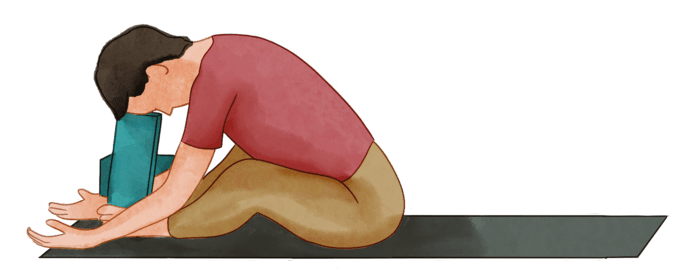
This seated fold is often practiced in Yin, Vinyasa, and Hatha Yoga to free up hip mobility. Place a yoga block under each leg or the head to reap the benefits of the stretch without pushing past your limits.
How to Practice Butterfly Pose with a Yoga Block:
- Seated on the mat with your legs straight out in front of you, bring the soles of your feet together to meet in the center.
- Place a yoga block under your forehead to support your neck and reduce strain in the legs, neck and back. Make sure you are sitting upright with your weight evenly distributed on your sitting bones. (If your legs struggle to come into this pose, try placing a block under each thigh to relieve pressure from the area.)
- Breathe in and lengthen up through the crown of your head.
- Breathe out and bend forward with a straight back. Once bent forward, you can relax your back and push deeper into the pose by lowering the yoga block.
Also Read- How To Practice Pigeon Pose
Fish Pose (Matsyasana)

Fish Pose is an excellent chest and throat opener, but it can be a challenging pose to maintain longer than 30-60 seconds at a time. Without support, the Fish Pose requires quite some arm-strength. You can use a yoga block to provide full support for a relaxed long-held pose.
How to Practice Fish Pose with a Yoga Block:
- Seated on the mat with your legs straight out in front of you, place a yoga block in the center of your mat – in line with your shoulder blades.
- Lie down and adjust your yoga block so it sits comfortably between your shoulder blades.
- Place your arms out beside you with your palms facing upward.
- Open your chest and relax your weight onto the yoga block.
- If it feels good, completely relax your neck and head onto the mat. If you feel your neck or back beginning to strain, place a yoga block under your head for additional support.
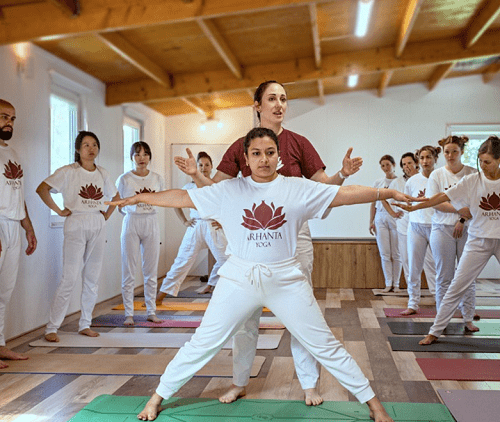
Experience authentic Hatha Yoga
Get free access to exclusive guided lessons with master teacher Kalyani Hauswirth-Jain
3. Strengthen
Incorporating yoga blocks into your practice is a fantastic way to intensify poses and build more strength in a functional and safe way. Additionally, the tools offer support and stability in challenging poses, allowing you to advance your practice and bolster your confidence.
Four-Limbed Staff Pose (Chaturanga Dandasana)
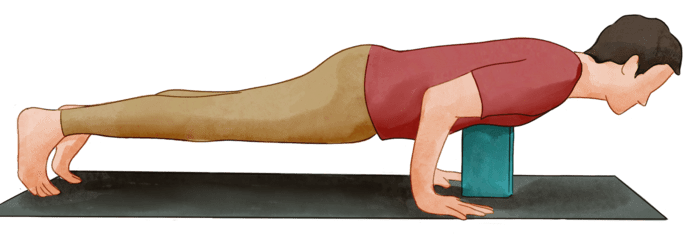
Four-Limbed Staff Pose, or Chaturanga Dandasana, is a challenging asana that requires a strong upper body and core. Modifying this pose with a yoga block will ensure that you gradually build up strength while keeping your elbows aligned and your core and back engaged.
How to Practice Four-Limbed Staff Pose with a Yoga Block:
- Start on all fours with wrists underneath the shoulders and the knees in line with the hips.
- Place a yoga block below your chest.
- Then, come into Plank Pose and slowly bend your elbows, squeezing them next to your sides.
- Gaze forward and engage your arms and core. Hover just above the block and use it to keep your elbows and body aligned.
- Press into your hands and feel as your arms, wrists, back, and core begin to strengthen.
Boat Pose (Paripurna Navasana)
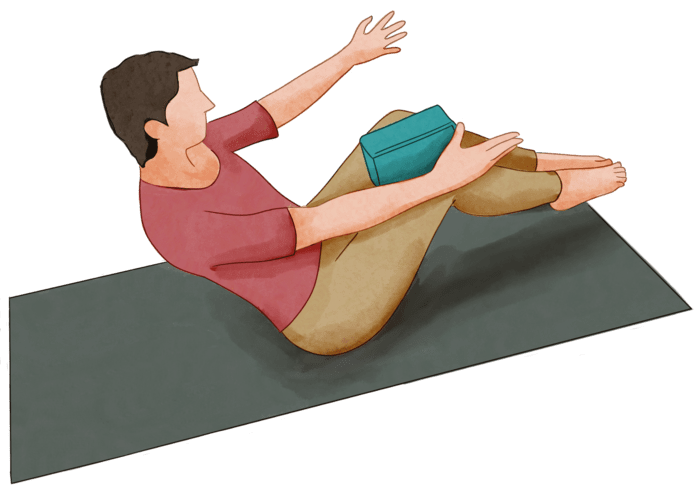
Boat Pose draws on a combination of strength, flexibility, balance, and mental focus. Try squeezing a yoga block between your thighs to tone-up your Boat Pose. This will activate your abductors and core muscles, promoting a more intense asana practice.
How to Practice Boat Pose with a Yoga Block:
- Sit with your feet on the mat – knees together and slightly bent.
- With the yoga block squeezed between your thighs, lean back and grab ahold of the back of your thighs.
- Lean back at a 45-degree angle, draw your belly in, and lift your feet off the floor.
- Keeping your knees bent, let go of your thighs and reach your hands forward at shoulder level.
- Continue to squeeze your yoga block and feel your core and adductors begin to burn.
- If you are mobile enough, you can increase the intensity by straightening your legs up toward the sky.
Tips for Buying and Using Yoga Blocks
Which Type of Yoga Block is Best?
If you have practiced yoga for some time, you would have encountered various yoga blocks. Some of the most commonly used in studios today are cork blocks, foam blocks, and wooden blocks.
When choosing a yoga block, you must consider your personal preference and specific needs. Here’s a comparison of cork, foam, and wooden yoga blocks to help you select the perfect yoga block for your individual practice.
Cork yoga blocks:
- Eco-friendly and sustainable
- Dense and easy to grip
- Provide a sturdy, non-slip surface
- Good for support and stability in balancing poses
- Can absorb sweat and odors
- Not as durable as wood or foam blocks
Foam yoga blocks:
- Lightweight and inexpensive
- Soft and slip-resistant
- Come in a variety of colors
- Good for support and modifying poses
- Not as eco-friendly as cork
- Ideal for restorative postures
Wooden yoga blocks:
- Sturdy and durable
- More expensive than foam and cork yoga blocks
- Solid but can become slippery when wet
- Good for support and stability in balancing poses
- Can be heavy and less portable than foam or cork blocks
- Uncomfortable for Restorative Yoga
When choosing a yoga block, you should also consider your preferred yoga style. For example, yoga styles like Restorative and Yin involve passive poses that are sometimes held for several minutes at a time. For these practices, it might be best to have a softer block like a cork or foam on hand. However, for practices with a lot of standing poses, a solid, wooden block is ideal.
Yoga Block Alternatives
If you don’t have a yoga block lying around, the following items can be used as a substitute to provide support and an extra challenge in your practice:
- Block of wood
- Stuffed cushion
- Folded blankets
- Rolled-up yoga mat
- Stack of books
- Sturdy box
Before incorporating these into your practice, test them out and make sure they are fit for the job. Your yoga block should be stable and solid enough to hold your body weight, so it shouldn’t shift unexpectedly or collapse mid pose.
People often search for – Benefits of Pigeon Pose
How Many Yoga Blocks Do I Need?
When starting off, two yoga blocks are more than sufficient: one for each side of your body.
How Do I Know Which Height is Right?
The height of the yoga block you use will depend on your height, flexibility, and the specific yoga block poses you are practicing.
Typically, the standard size for a yoga block is 9″ x 6″ x 4″, which is suitable for most people and poses and is used in most yoga classes. However, a higher block (e.g. 5 or 6 inches) may be more suitable if you are taller or have limited flexibility. Conversely, if you are shorter or have more flexibility, a lower block (e.g. 3 inches) will widen the gap in complex poses while still offering support.
In general, it’s a good idea to try out different heights of blocks and see what feels most comfortable and supportive for you. It may also be helpful to ask a qualified yoga instructor for guidance when choosing the right block height for your needs.
Are Yoga Blocks Worth It? 4 Benefits
BKS Iyengar said, “The body is the prop for the soul. So why not let the body be propped by a wall or a block?” Although yoga blocks might not be absolutely necessary for all of your practices, using their support can help your progress and advance into a more skilled and confident yoga practitioner.
Here are a few benefits you can reap by adding a block to your daily practice:
1. Improves Flexibility and Balance
Yoga asanas like Crow Pose require you to balance your entire body on two hands. In advanced balancing poses like this, yoga blocks offer additional support and allow you to refine your balance safely and effectively. These props can also help you bridge the gap in yoga folds and twists, improving your overall range of motion and flexibility.
2. Advance without Injury
As mentioned above, yoga blocks offer support when you need balance, a solid base, or a gentle boost in your practice. For practitioners wanting to advance their practice, these blocks ensure proper alignment and provide a pillar to lean on if needed. This gives you the guidance and support to attempt complex asanas without causing strain or injury.
3. Releases Tension
Practicing Restorative Yoga block poses can offer a more intense and healing stretch. Blocks can support the body in these asanas, promoting comfort and relaxation without causing strain or discomfort. Many practitioners also utilize yoga blocks during meditation and Yoga Nidra to support the neck, back, or head and settle into a deeper state of relaxation.
4. Builds Confidence and Strength
Yoga blocks can both simplify and intensify an asana. Advanced yoga practitioners can use these props to engage critical muscles and practice asanas safely and correctly. Beginners can also gradually advance their practice with the support of a yoga block, boosting their confidence and skills as a yogi.
Final Thought
The humble yoga block might be a regular rectangular brick. Still, if you know how to use yoga blocks correctly, this versatile tool can enhance, strengthen, and support your yoga practice in wondrous ways. Whether you wish to attempt more complex poses or build strength and improve your balance, this powerful prop gives you the support and push to empower your practice.
Read more – Yoga for Sciatica

Experience authentic Hatha Yoga
Get free access to exclusive guided lessons with master teacher Kalyani Hauswirth-Jain

